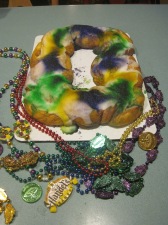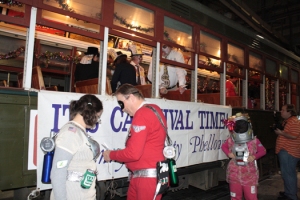In much of the United States, Christmas is over. Christmas trees on the curb the morning of December 6th. However, according to the Romans Catholic liturgical calendar, Christmas does not start until Christmas Eve and ends on January 6th, known as Epiphany or Twelfth Night. And in Roman Catholic New Orleans, the Church calendar defines Christmas and the weeks beyond.
In New Orleans and much of the Gulf Coast, Epiphany or King’s Night celebrates the revelation of Jesus to the non-Jewish people of the world, represented by Magi or three kings. It is the feast of gift giving celebrated in much of the Roman Catholic world. For New Orleans, it marks both the end of Christmas and the beginning of Carnival.
So, while it marks the close of the Christmas season, Epiphany is the beginning of the Carnival season. And as such, it marks the first appearance of the ubiquitous king cake, which is generally round in shape, with cinnamon flavoring, decorated with glaze or colored sugar in Carnival colors (purple, green and gold). It contains a baby (representing the baby Jesus), a bean, or other trinket. Traditionally, the lucky celebrant who finds this item must provide the next king cake.
Carnival season ends with Mardi Gras or Fat Tuesday, which is followed by the 40-day Lenten season running up to Easter. King cakes may be served throughout Carnival or king cake season. However, much more goes on during the days leading up to Mardi Gras. In fact, the first Carnival Krewes emerge this weekend to mark a succession of balls, parades, and winter celebrations.
On the evening of January 6th, a relatively new Krewe of Jeanne d’Arc parades through the French Quarter to mark her birthday and Twelfth Night. The krewe also marks the historical ties between France and New Orleans. A little bit later in the evening, the costumed Phunny Phorty Phellows, the modern incarnation which began in 1981, take over the St. Charles streetcar line, thus marking the anarchic beginning of Carnival.
Thus in New Orleans, the end of one celebration coincides with first day of a new one. And one season of revelry begets another.

